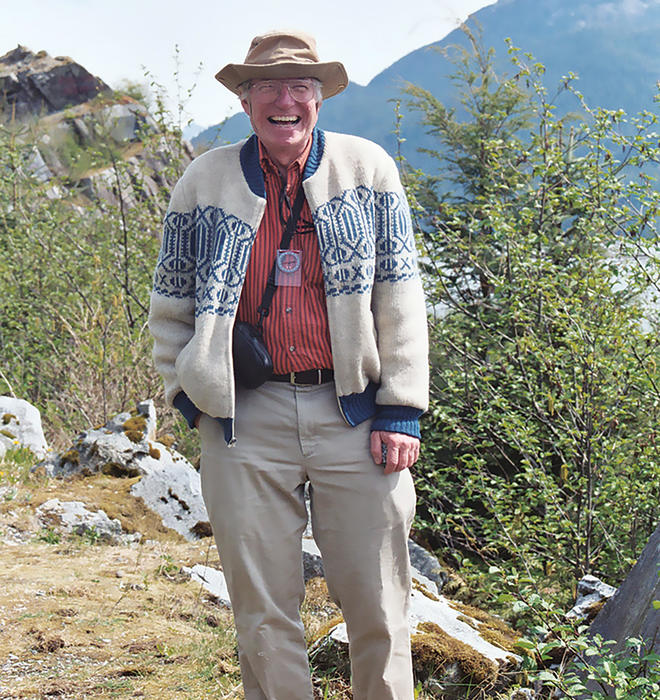
Oct. 10, 1935 — July 31, 2023
In April 1967, W. Jason Morgan *64 was scheduled to speak at an American Geophysical Union meeting in Washington, D.C., expanding some research he had published two years earlier. But he changed his mind and presented instead a work in progress, including new evidence that the Earth’s surface is made of large, rigid plates.
To Morgan’s son, Jason Phipps Morgan, the story was completely in character: His father was at his happiest when he was chasing some new area of inquiry, and “if he was excited about something, he wanted to share it.”
At the time, Morgan was a young assistant professor at Princeton. He’d spent about three months identifying patterns in the fracture zones on the ocean floor, and he stayed in his Guyot Hall office until 2 a.m. the night before his trip, preparing an outline of notes and graphs.
A later account said the room was packed with geologists who’d come to discuss the hot topic of sea floor spreading. But Morgan, in a 2018 Princeton lecture, corrected the record. “Most of the people left the room,” he said, “because I was the last talk before lunch break and it was already 20 minutes past noon.”
No matter. “Rises, Trenches, Great Faults, and Crustal Blocks,” the paper set in motion by Morgan’s talk, was published less than a year later in the Journal of Geophysical Research and became one of the key works in the plate tectonics revolution. A few years after that, he made another monumental contribution to the field with his mantle-plume hypothesis, which aimed to explain volcanic formations located in the interior regions of a plate, instead of on the boundaries between plates — such as the Hawaiian islands.
“There was nothing about him that would tell you, at that very minute, he had just changed the world.”
— Lincoln Hollister
Professor emeritus of geosciences
With plate tectonics, “all of geology could be summarized with astounding elegance,” as Lawrence Cathles ’65 *71, Morgan’s first graduate student, wrote in a Nature obituary for his late mentor. Cathles, a professor emeritus at Cornell University, tells PAW that the theory was also remarkable for how quickly it was accepted by those in the discipline. “It was essentially complete in only about 10 years,” he says.
Morgan would go on to receive honorary doctorates, major awards in his field, and the National Medal of Science, but colleagues say he never took on the mantle of a star professor or rested on his past accomplishments.
Lincoln Hollister, a professor emeritus of geosciences and Morgan’s friend for more than 50 years, joined the faculty in the late 1960s, just as plate tectonics was taking form. Morgan, he says, had a habit of quietly drifting into the other offices at Guyot, sometimes to chat and sometimes just to listen.
“There was nothing about him that would tell you, at that very minute, he had just changed the world,” Hollister says.
Becoming a professor was a somewhat unexpected path for Morgan, who grew up in Savannah, Georgia, and attended Georgia Tech on a Navy ROTC scholarship. Joining his family’s hardware business might have been a more conventional route, but after graduating with a physics degree, Morgan was assigned to a teaching job at the Naval Nuclear Power School in New London, Connecticut. His two years in the Navy proved transformative. Through conversations with his fellow instructors, he began to think seriously about graduate school; and he met his future wife, Cary, then a student at nearby Connecticut College.
Morgan completed his dissertation in Princeton’s physics department under the direction of Robert Dicke ’39, who eventually recommended him to Harry Hess *32, the geology department chair, as a potential geophysicist.
When explaining how he came up with his insights on plate tectonics, Morgan would reference a range of subjects he’d encountered before coming to Princeton, from spherical trigonometry to cartography. Hollister calls him “the last person who knew everything.” Cathles adds, “He was really driven by the geology, trying to understand the Earth. So he was a geologist in no uncertain terms.”
For most of Morgan’s years in Princeton, the places that mattered most to him were within a half-mile radius: Guyot, the computer center, and his family home in the Ferris Thompson Apartments. Living in faculty housing made it easier to travel in the summers, says daughter Michèle Morgan ’85, and when her father went to visit colleagues, the family went along, driving cross country and camping in national parks. “By the time I was 15, I’d been to the lower 48,” Michèle Morgan says.
Morgan’s love of travel resonated with his fellow Princeton geoscientists, including Hollister, who says they shared a belief in “geobonding,” the collegiality that develops from spending a week or two together in the field. In the 1980s and ’90s, Morgan was among the professors who taught a popular freshman seminar that included a weeklong trip to geologically interesting sites in California, from Death Valley to the Inyo Craters.
Though Morgan retired and moved to Massachusetts in 2004, he remained engaged academically as a visiting scholar at Harvard and kept in touch with Princeton colleagues, including Hollister, who spoke with him four or five times a week until Morgan’s death in July. Hollister says their last conversation, like innumerable ones before it, was about geology — specifically, a feature on the Colorado plateau. His curiosity never faded.
Brett Tomlinson is PAW’s managing editor.






No responses yet